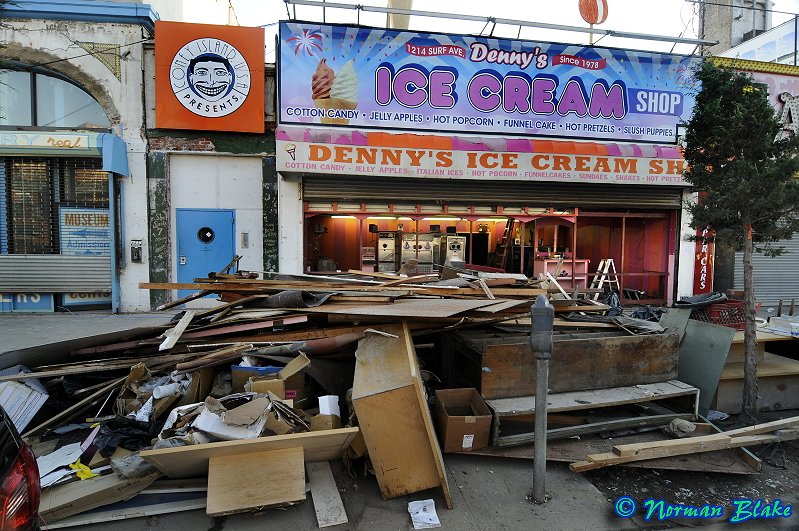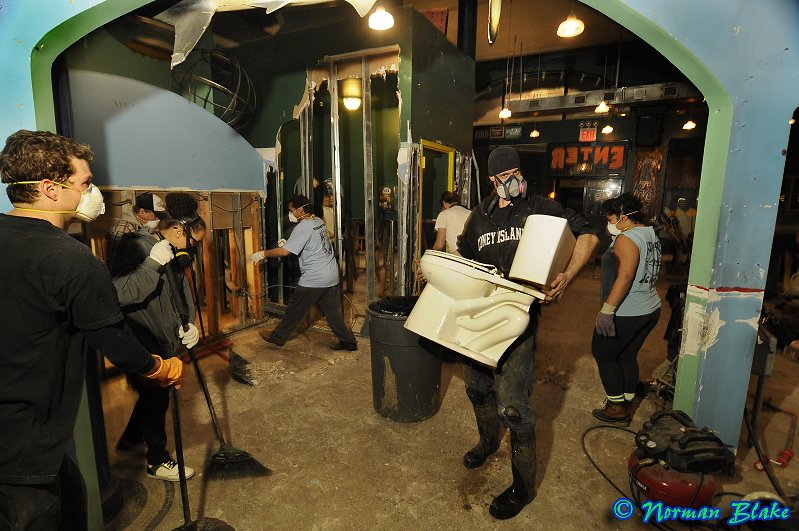Hurricane Sandy, 10 Years
On October 29, 2012, New York City came face to face with Hurricane Sandy. The storm had spent the previous seven days building strength across the Caribbean and working its way up the Atlantic Ocean, ultimately making landfall near Atlantic City, NJ. The storm winds stretched 1,000 miles from end-to-end, three times greater than a normal hurricane. These winds contributed to the damage in Coney Island, which is just 124 miles from Atlantic City.
Due to its massive size, the hurricane created an unexpected storm surge that raised the water levels across the entire East Coast, stretching from Florida to Maine. The tri-state area saw the worst of the storm surge, with New York City being one of the locations that suffered the greatest impact, due to the storm’s timing — at high tide and during a full moon. As it approached the tri-state area, the strong winds shifted from blowing southward to northwestward, adding more water to the already high surge and pushing it directly into the southern coastline of New York City, which includes Coney Island. Because Coney Island is a peninsula, the area also saw water rise from the north, along Coney Island Creek.
Each year, approximately 1,487 million gallons of stormwater and 290 million gallons of sewage runoff into Coney Island Creek. As a result of the creek’s overflow during Sandy, homes, and businesses were inundated with sewage waste, in addition to the already damaging saltwater from the ocean. The toxic combination of salt water and sewage damaged property, which needed to be thrown away because of bacterial contamination; anything salvageable needed to be thoroughly disinfected.
The flooding in New York City exceeded any estimated, once-in-a-lifetime flood plans. Flooding in the Coney Island peninsula reached 11 feet above ground level. Almost every establishment in Coney Island was impacted in some way. Cars and buildings were flooded down to Neptune Ave, which is about half a mile from the boardwalk. Coney Island Hospital, which is about .3 miles past Neptune Ave, experienced knee-deep water, which shut down the facility’s boilers and power. The damage caused the hospital to remain closed for months.
Close to 50,000 homes in the Coney Island area were made uninhabitable by the storm. Coney Island is historically a low-income neighborhood with numerous mom-and-pop businesses; many had a difficult time rebuilding their lives. Many establishments never reopened.
Coney Island USA’s General Manager, Patrick Wall, waited out the storm in the building 1208 Surf Avenue. On the occasion of the 10th anniversary of Hurricane Sandy, he reflects on his experience before, during, and after the storm. He would like to extend his gratitude to all the supporters, friends, and fans who helped get Coney Island USA ready to open again.
The water filling CIUSA’s first floor and rushing along Surf Ave; video by Patrick Wall
Photo by Jim McDonnell
Photo by Jim McDonnell
Photo by Jim McDonnell
Photo by Jim McDonnell
Photo by Jim McDonnell
Photo by Patrick Wall
Photo by Norman Blake
Photo by Jim McDonnell
Photo by Jim McDonnell
Photo by Norman Blake
Photo by Patrick Wall
Photo by Patrick Wall
Photo by Patrick Wall
Photo by Norman Blake
Photo by Jim McDonnell
Photo by Norman Blake
Photo by Norman Blake
Photo by Jim McDonnell
Photo by Jim McDonnell
Photo by Raymond Adams
Photo by Raymond Adams
Photo by Raymond Adams
Photo by Raymond Adams
Today, residents and establishments are still recovering and reopening from Hurricane Sandy. Many local businesses are trying to build with consideration for future storm resistance.
New Yorkers are still finding their subway commutes disrupted by service changes caused by Sandy-related repairs. Twenty-seven million gallons of water flooded the Coney Island rail yard, one of the largest transportation facilities in the country and the largest in New York State. Various MTA projects have been initiated as part of the MTA’s hurricane recovery and resiliency plan. Those plans have included the installation of flood barrier systems on the different subway lines serviced by the rail yard, as well as fortifying the rail yard itself. These improvements are projected to be completed in 2023.
NYCHA residents in Coney Island have been suffering from heating issues in their buildings stemming from post-Sandy recovery projects. Storm-damaged boilers and generators were installed improperly, resulting in many apartments not receiving gas for prolonged periods of time. But, as part of NYCHA’s Hurricane Sandy Disaster Recovery Program, buildings are receiving boilers that are elevated off the ground; generators are being installed on buildings’ roofs; and external walls are being reinforced to withstand the pressure of water against the exterior, as well as seepage of the water into the building.
The New York Aquarium was finally able to fully reopen in July of 2022. In the10 years since Sandy, the Aquarium has restored and repaired their exhibits, while adding infrastructure improvements to better protect their facilities and the animals in the event of a future storm.
A message from our Artistic Director, Adam Rinn:
Although it's been a decade since Hurricane Sandy devastated the first floor of our beloved building, we continue to struggle with issues resulting from that terrible storm. Built in 1917, Coney Island USA’s headquarters is the oldest landmarked building in Coney Island's historic amusement district; we face infrastructure issues on a daily basis. Your support is critical to keeping the building maintained and ensuring it stands strong for the next 105 years.
Click here to donate. We graciously and humbly thank you for your support!
Thank you to Norman Blake, Raymond Adams, and Jim McDonnell who contributed photographs.
Thank you to everyone else who volunteered and showed their support 10 years ago, and to everyone that continues to support Coney Island USA today.
Thank you to Debi Ryan, Kate Wirth, Laure Leber, Rob Leddy, and all Coney Island staff who assisted in or contributed to different aspects of the recovery process.
A special thank you to those who volunteered their time, energy, and skills to help Coney Island USA clean up and rebuild-
Juliet Jeske, Amanda Jencsik. Alix Martin, Kate Dale, Tim Porter, Andy Zig, Chris Miano, Stephanie Torres, Christine Nessim, Betsy Propane, and Angie Pontani and Brian Newman
Curated by Eliza Rinn
























